H&M: Macro Environment and Competitive Analysis Report
VerifiedAdded on 2022/09/14
|12
|3549
|40
Report
AI Summary
This report provides a comprehensive analysis of H&M's business practices, focusing on the macro environment and competitive forces. It begins with an introduction to H&M, highlighting its global presence and business model. The core of the report involves a detailed PESTEL analysis, examining the political, economic, social, technological, environmental, and legal factors influencing H&M's operations across 71 countries. The report explores the impact of political instability, economic trends, social awareness of sustainability, technological advancements in online shopping, environmental goals, and legal disputes on the company's performance. Furthermore, the report applies Porter's Five Forces model to assess the competitive landscape, analyzing the bargaining power of buyers and suppliers, the threat of substitutes and new entrants, and industry rivalry. The analysis reveals the competitive dynamics within the fashion industry and the strategic implications for H&M. The report concludes by summarizing key opportunities and threats identified through the PESTEL framework and Porter's Five Forces, offering insights into H&M's sustainable and competitive strategies. The report emphasizes the importance of adapting to external factors to ensure a successful future for the company.
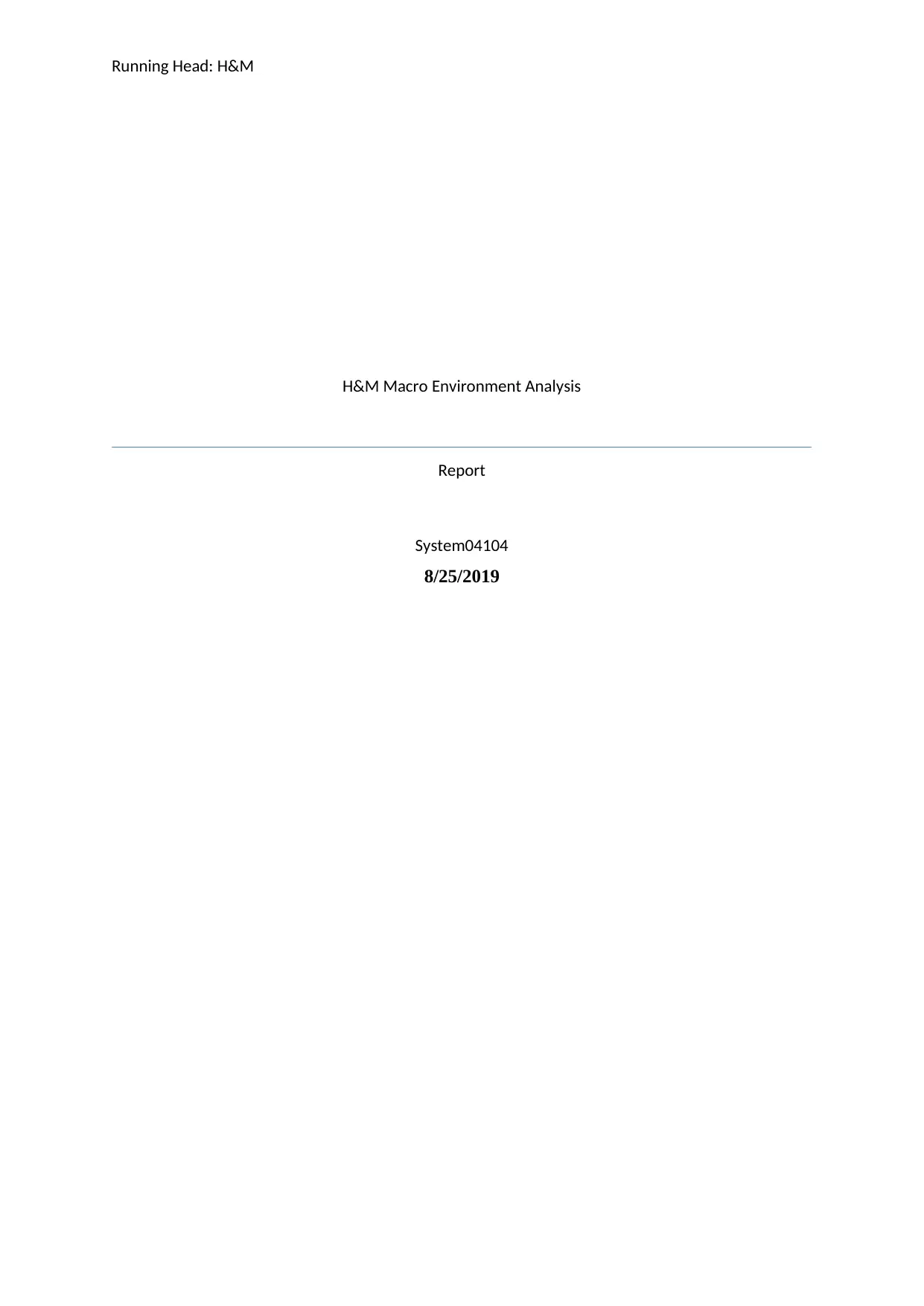
Running Head: H&M
H&M Macro Environment Analysis
Report
System04104
8/25/2019
H&M Macro Environment Analysis
Report
System04104
8/25/2019
Paraphrase This Document
Need a fresh take? Get an instant paraphrase of this document with our AI Paraphraser
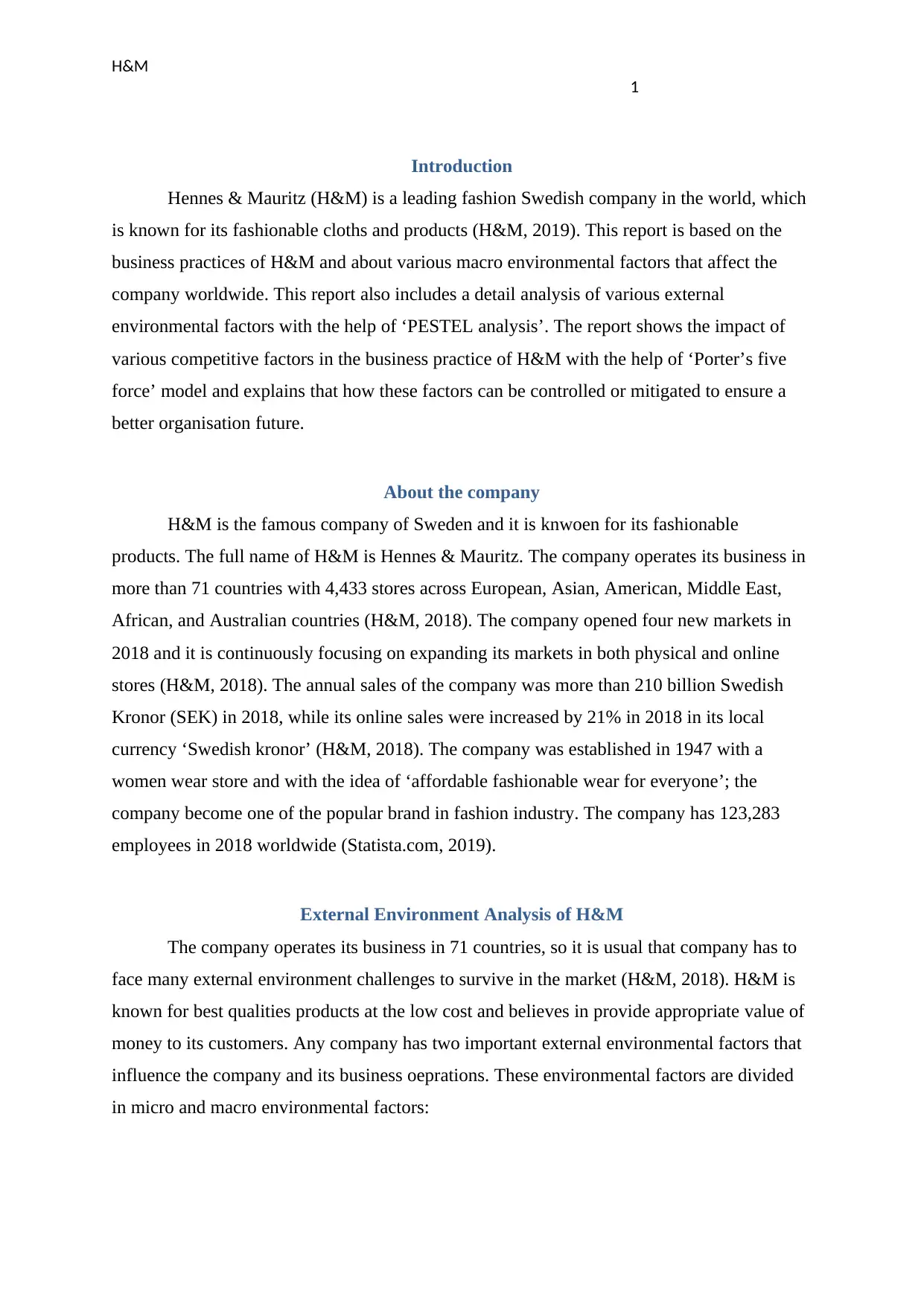
H&M
1
Introduction
Hennes & Mauritz (H&M) is a leading fashion Swedish company in the world, which
is known for its fashionable cloths and products (H&M, 2019). This report is based on the
business practices of H&M and about various macro environmental factors that affect the
company worldwide. This report also includes a detail analysis of various external
environmental factors with the help of ‘PESTEL analysis’. The report shows the impact of
various competitive factors in the business practice of H&M with the help of ‘Porter’s five
force’ model and explains that how these factors can be controlled or mitigated to ensure a
better organisation future.
About the company
H&M is the famous company of Sweden and it is knwoen for its fashionable
products. The full name of H&M is Hennes & Mauritz. The company operates its business in
more than 71 countries with 4,433 stores across European, Asian, American, Middle East,
African, and Australian countries (H&M, 2018). The company opened four new markets in
2018 and it is continuously focusing on expanding its markets in both physical and online
stores (H&M, 2018). The annual sales of the company was more than 210 billion Swedish
Kronor (SEK) in 2018, while its online sales were increased by 21% in 2018 in its local
currency ‘Swedish kronor’ (H&M, 2018). The company was established in 1947 with a
women wear store and with the idea of ‘affordable fashionable wear for everyone’; the
company become one of the popular brand in fashion industry. The company has 123,283
employees in 2018 worldwide (Statista.com, 2019).
External Environment Analysis of H&M
The company operates its business in 71 countries, so it is usual that company has to
face many external environment challenges to survive in the market (H&M, 2018). H&M is
known for best qualities products at the low cost and believes in provide appropriate value of
money to its customers. Any company has two important external environmental factors that
influence the company and its business oeprations. These environmental factors are divided
in micro and macro environmental factors:
1
Introduction
Hennes & Mauritz (H&M) is a leading fashion Swedish company in the world, which
is known for its fashionable cloths and products (H&M, 2019). This report is based on the
business practices of H&M and about various macro environmental factors that affect the
company worldwide. This report also includes a detail analysis of various external
environmental factors with the help of ‘PESTEL analysis’. The report shows the impact of
various competitive factors in the business practice of H&M with the help of ‘Porter’s five
force’ model and explains that how these factors can be controlled or mitigated to ensure a
better organisation future.
About the company
H&M is the famous company of Sweden and it is knwoen for its fashionable
products. The full name of H&M is Hennes & Mauritz. The company operates its business in
more than 71 countries with 4,433 stores across European, Asian, American, Middle East,
African, and Australian countries (H&M, 2018). The company opened four new markets in
2018 and it is continuously focusing on expanding its markets in both physical and online
stores (H&M, 2018). The annual sales of the company was more than 210 billion Swedish
Kronor (SEK) in 2018, while its online sales were increased by 21% in 2018 in its local
currency ‘Swedish kronor’ (H&M, 2018). The company was established in 1947 with a
women wear store and with the idea of ‘affordable fashionable wear for everyone’; the
company become one of the popular brand in fashion industry. The company has 123,283
employees in 2018 worldwide (Statista.com, 2019).
External Environment Analysis of H&M
The company operates its business in 71 countries, so it is usual that company has to
face many external environment challenges to survive in the market (H&M, 2018). H&M is
known for best qualities products at the low cost and believes in provide appropriate value of
money to its customers. Any company has two important external environmental factors that
influence the company and its business oeprations. These environmental factors are divided
in micro and macro environmental factors:
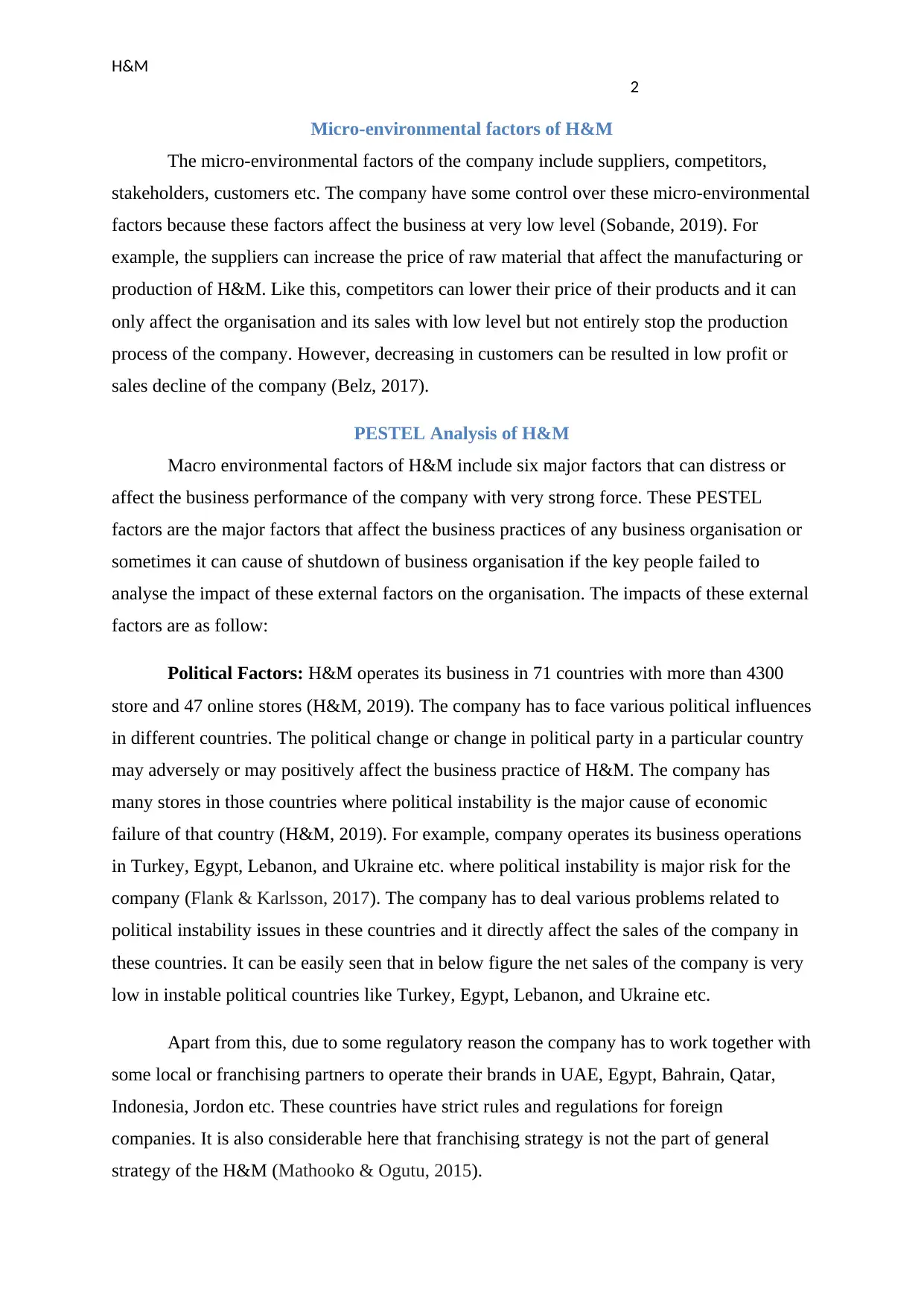
H&M
2
Micro-environmental factors of H&M
The micro-environmental factors of the company include suppliers, competitors,
stakeholders, customers etc. The company have some control over these micro-environmental
factors because these factors affect the business at very low level (Sobande, 2019). For
example, the suppliers can increase the price of raw material that affect the manufacturing or
production of H&M. Like this, competitors can lower their price of their products and it can
only affect the organisation and its sales with low level but not entirely stop the production
process of the company. However, decreasing in customers can be resulted in low profit or
sales decline of the company (Belz, 2017).
PESTEL Analysis of H&M
Macro environmental factors of H&M include six major factors that can distress or
affect the business performance of the company with very strong force. These PESTEL
factors are the major factors that affect the business practices of any business organisation or
sometimes it can cause of shutdown of business organisation if the key people failed to
analyse the impact of these external factors on the organisation. The impacts of these external
factors are as follow:
Political Factors: H&M operates its business in 71 countries with more than 4300
store and 47 online stores (H&M, 2019). The company has to face various political influences
in different countries. The political change or change in political party in a particular country
may adversely or may positively affect the business practice of H&M. The company has
many stores in those countries where political instability is the major cause of economic
failure of that country (H&M, 2019). For example, company operates its business operations
in Turkey, Egypt, Lebanon, and Ukraine etc. where political instability is major risk for the
company (Flank & Karlsson, 2017). The company has to deal various problems related to
political instability issues in these countries and it directly affect the sales of the company in
these countries. It can be easily seen that in below figure the net sales of the company is very
low in instable political countries like Turkey, Egypt, Lebanon, and Ukraine etc.
Apart from this, due to some regulatory reason the company has to work together with
some local or franchising partners to operate their brands in UAE, Egypt, Bahrain, Qatar,
Indonesia, Jordon etc. These countries have strict rules and regulations for foreign
companies. It is also considerable here that franchising strategy is not the part of general
strategy of the H&M (Mathooko & Ogutu, 2015).
2
Micro-environmental factors of H&M
The micro-environmental factors of the company include suppliers, competitors,
stakeholders, customers etc. The company have some control over these micro-environmental
factors because these factors affect the business at very low level (Sobande, 2019). For
example, the suppliers can increase the price of raw material that affect the manufacturing or
production of H&M. Like this, competitors can lower their price of their products and it can
only affect the organisation and its sales with low level but not entirely stop the production
process of the company. However, decreasing in customers can be resulted in low profit or
sales decline of the company (Belz, 2017).
PESTEL Analysis of H&M
Macro environmental factors of H&M include six major factors that can distress or
affect the business performance of the company with very strong force. These PESTEL
factors are the major factors that affect the business practices of any business organisation or
sometimes it can cause of shutdown of business organisation if the key people failed to
analyse the impact of these external factors on the organisation. The impacts of these external
factors are as follow:
Political Factors: H&M operates its business in 71 countries with more than 4300
store and 47 online stores (H&M, 2019). The company has to face various political influences
in different countries. The political change or change in political party in a particular country
may adversely or may positively affect the business practice of H&M. The company has
many stores in those countries where political instability is the major cause of economic
failure of that country (H&M, 2019). For example, company operates its business operations
in Turkey, Egypt, Lebanon, and Ukraine etc. where political instability is major risk for the
company (Flank & Karlsson, 2017). The company has to deal various problems related to
political instability issues in these countries and it directly affect the sales of the company in
these countries. It can be easily seen that in below figure the net sales of the company is very
low in instable political countries like Turkey, Egypt, Lebanon, and Ukraine etc.
Apart from this, due to some regulatory reason the company has to work together with
some local or franchising partners to operate their brands in UAE, Egypt, Bahrain, Qatar,
Indonesia, Jordon etc. These countries have strict rules and regulations for foreign
companies. It is also considerable here that franchising strategy is not the part of general
strategy of the H&M (Mathooko & Ogutu, 2015).
⊘ This is a preview!⊘
Do you want full access?
Subscribe today to unlock all pages.

Trusted by 1+ million students worldwide
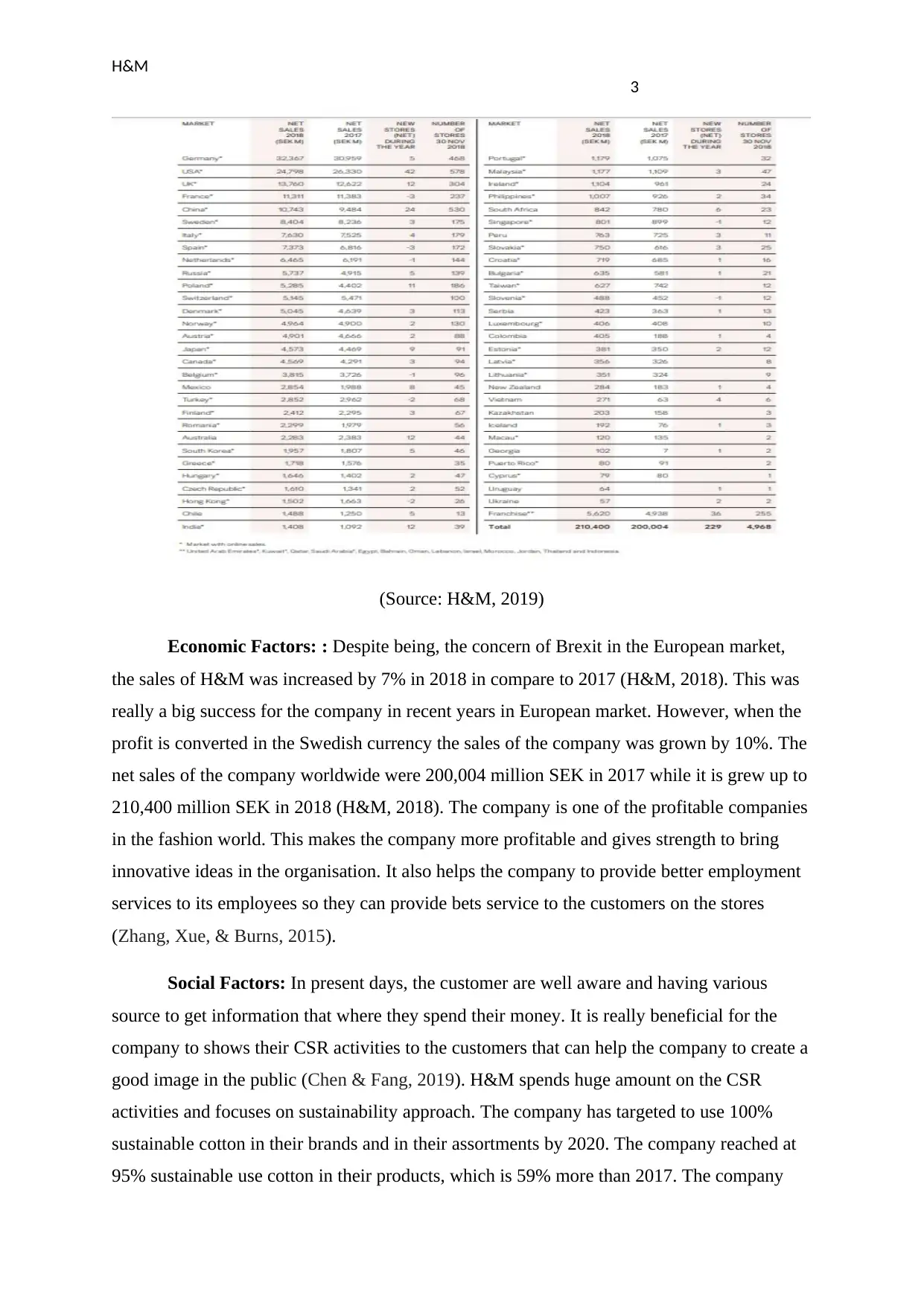
H&M
3
(Source: H&M, 2019)
Economic Factors: : Despite being, the concern of Brexit in the European market,
the sales of H&M was increased by 7% in 2018 in compare to 2017 (H&M, 2018). This was
really a big success for the company in recent years in European market. However, when the
profit is converted in the Swedish currency the sales of the company was grown by 10%. The
net sales of the company worldwide were 200,004 million SEK in 2017 while it is grew up to
210,400 million SEK in 2018 (H&M, 2018). The company is one of the profitable companies
in the fashion world. This makes the company more profitable and gives strength to bring
innovative ideas in the organisation. It also helps the company to provide better employment
services to its employees so they can provide bets service to the customers on the stores
(Zhang, Xue, & Burns, 2015).
Social Factors: In present days, the customer are well aware and having various
source to get information that where they spend their money. It is really beneficial for the
company to shows their CSR activities to the customers that can help the company to create a
good image in the public (Chen & Fang, 2019). H&M spends huge amount on the CSR
activities and focuses on sustainability approach. The company has targeted to use 100%
sustainable cotton in their brands and in their assortments by 2020. The company reached at
95% sustainable use cotton in their products, which is 59% more than 2017. The company
3
(Source: H&M, 2019)
Economic Factors: : Despite being, the concern of Brexit in the European market,
the sales of H&M was increased by 7% in 2018 in compare to 2017 (H&M, 2018). This was
really a big success for the company in recent years in European market. However, when the
profit is converted in the Swedish currency the sales of the company was grown by 10%. The
net sales of the company worldwide were 200,004 million SEK in 2017 while it is grew up to
210,400 million SEK in 2018 (H&M, 2018). The company is one of the profitable companies
in the fashion world. This makes the company more profitable and gives strength to bring
innovative ideas in the organisation. It also helps the company to provide better employment
services to its employees so they can provide bets service to the customers on the stores
(Zhang, Xue, & Burns, 2015).
Social Factors: In present days, the customer are well aware and having various
source to get information that where they spend their money. It is really beneficial for the
company to shows their CSR activities to the customers that can help the company to create a
good image in the public (Chen & Fang, 2019). H&M spends huge amount on the CSR
activities and focuses on sustainability approach. The company has targeted to use 100%
sustainable cotton in their brands and in their assortments by 2020. The company reached at
95% sustainable use cotton in their products, which is 59% more than 2017. The company
Paraphrase This Document
Need a fresh take? Get an instant paraphrase of this document with our AI Paraphraser
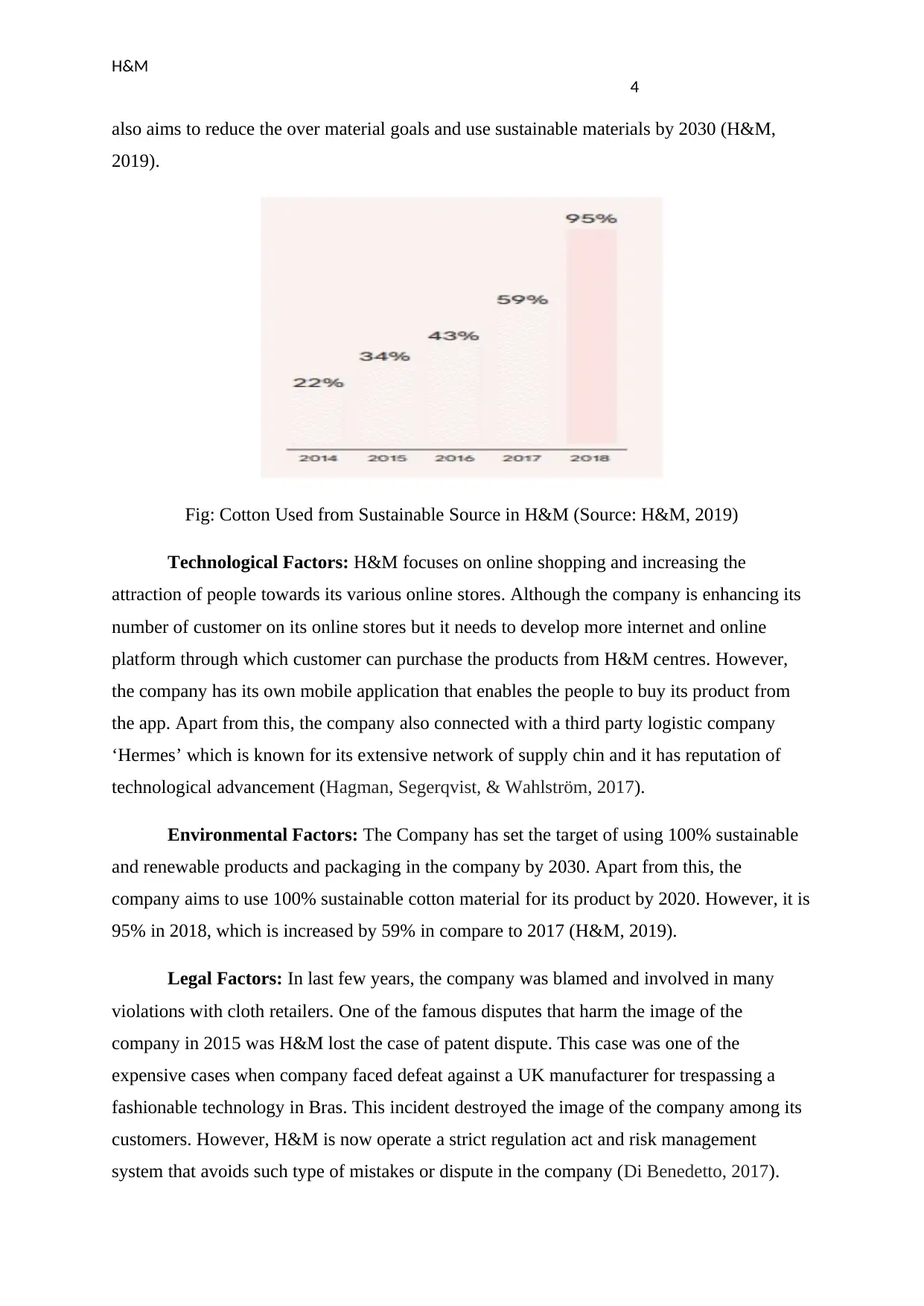
H&M
4
also aims to reduce the over material goals and use sustainable materials by 2030 (H&M,
2019).
Fig: Cotton Used from Sustainable Source in H&M (Source: H&M, 2019)
Technological Factors: H&M focuses on online shopping and increasing the
attraction of people towards its various online stores. Although the company is enhancing its
number of customer on its online stores but it needs to develop more internet and online
platform through which customer can purchase the products from H&M centres. However,
the company has its own mobile application that enables the people to buy its product from
the app. Apart from this, the company also connected with a third party logistic company
‘Hermes’ which is known for its extensive network of supply chin and it has reputation of
technological advancement (Hagman, Segerqvist, & Wahlström, 2017).
Environmental Factors: The Company has set the target of using 100% sustainable
and renewable products and packaging in the company by 2030. Apart from this, the
company aims to use 100% sustainable cotton material for its product by 2020. However, it is
95% in 2018, which is increased by 59% in compare to 2017 (H&M, 2019).
Legal Factors: In last few years, the company was blamed and involved in many
violations with cloth retailers. One of the famous disputes that harm the image of the
company in 2015 was H&M lost the case of patent dispute. This case was one of the
expensive cases when company faced defeat against a UK manufacturer for trespassing a
fashionable technology in Bras. This incident destroyed the image of the company among its
customers. However, H&M is now operate a strict regulation act and risk management
system that avoids such type of mistakes or dispute in the company (Di Benedetto, 2017).
4
also aims to reduce the over material goals and use sustainable materials by 2030 (H&M,
2019).
Fig: Cotton Used from Sustainable Source in H&M (Source: H&M, 2019)
Technological Factors: H&M focuses on online shopping and increasing the
attraction of people towards its various online stores. Although the company is enhancing its
number of customer on its online stores but it needs to develop more internet and online
platform through which customer can purchase the products from H&M centres. However,
the company has its own mobile application that enables the people to buy its product from
the app. Apart from this, the company also connected with a third party logistic company
‘Hermes’ which is known for its extensive network of supply chin and it has reputation of
technological advancement (Hagman, Segerqvist, & Wahlström, 2017).
Environmental Factors: The Company has set the target of using 100% sustainable
and renewable products and packaging in the company by 2030. Apart from this, the
company aims to use 100% sustainable cotton material for its product by 2020. However, it is
95% in 2018, which is increased by 59% in compare to 2017 (H&M, 2019).
Legal Factors: In last few years, the company was blamed and involved in many
violations with cloth retailers. One of the famous disputes that harm the image of the
company in 2015 was H&M lost the case of patent dispute. This case was one of the
expensive cases when company faced defeat against a UK manufacturer for trespassing a
fashionable technology in Bras. This incident destroyed the image of the company among its
customers. However, H&M is now operate a strict regulation act and risk management
system that avoids such type of mistakes or dispute in the company (Di Benedetto, 2017).
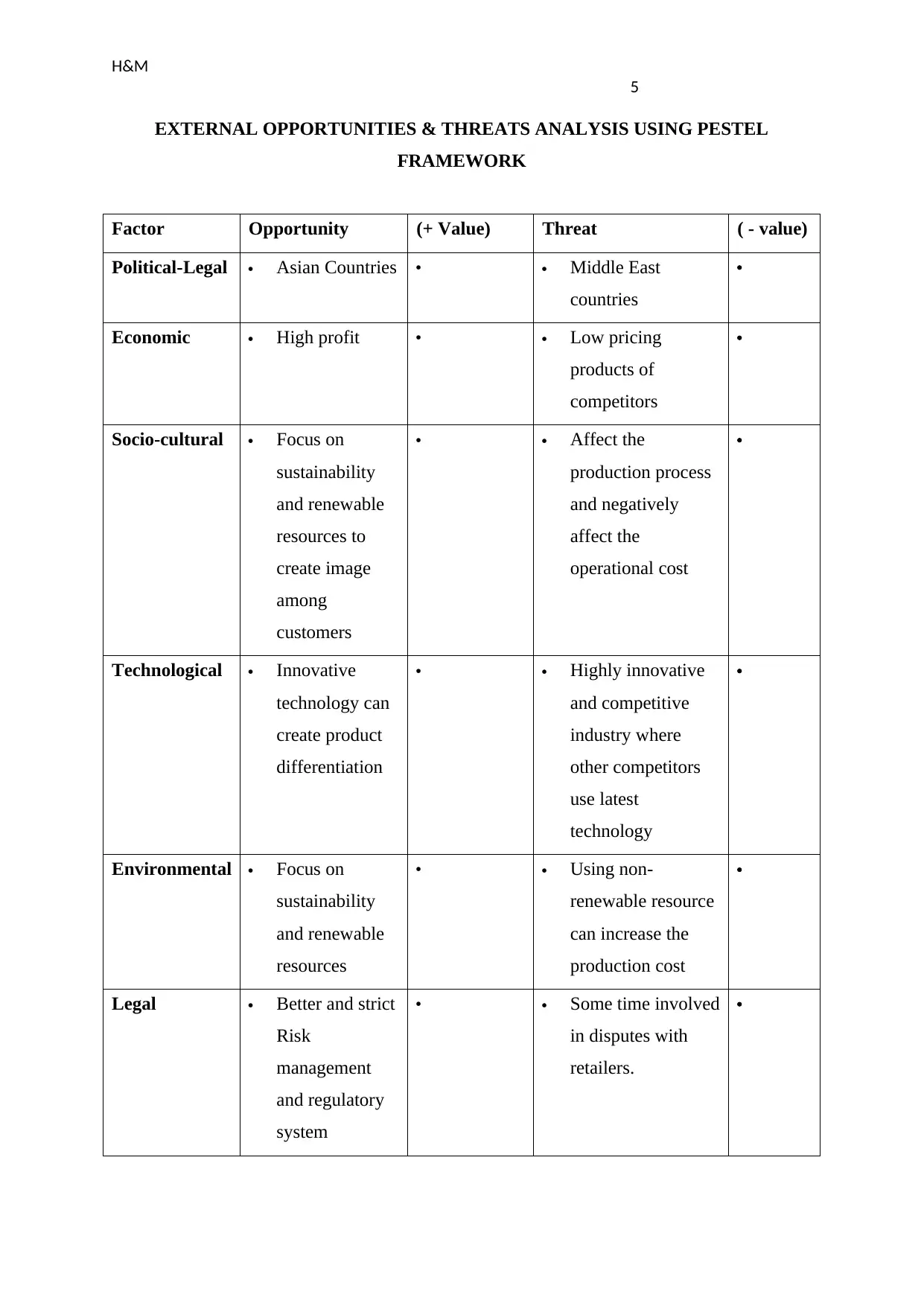
H&M
5
EXTERNAL OPPORTUNITIES & THREATS ANALYSIS USING PESTEL
FRAMEWORK
Factor Opportunity (+ Value) Threat ( - value)
Political-Legal Asian Countries Middle East
countries
Economic High profit Low pricing
products of
competitors
Socio-cultural Focus on
sustainability
and renewable
resources to
create image
among
customers
Affect the
production process
and negatively
affect the
operational cost
Technological Innovative
technology can
create product
differentiation
Highly innovative
and competitive
industry where
other competitors
use latest
technology
Environmental Focus on
sustainability
and renewable
resources
Using non-
renewable resource
can increase the
production cost
Legal Better and strict
Risk
management
and regulatory
system
Some time involved
in disputes with
retailers.
5
EXTERNAL OPPORTUNITIES & THREATS ANALYSIS USING PESTEL
FRAMEWORK
Factor Opportunity (+ Value) Threat ( - value)
Political-Legal Asian Countries Middle East
countries
Economic High profit Low pricing
products of
competitors
Socio-cultural Focus on
sustainability
and renewable
resources to
create image
among
customers
Affect the
production process
and negatively
affect the
operational cost
Technological Innovative
technology can
create product
differentiation
Highly innovative
and competitive
industry where
other competitors
use latest
technology
Environmental Focus on
sustainability
and renewable
resources
Using non-
renewable resource
can increase the
production cost
Legal Better and strict
Risk
management
and regulatory
system
Some time involved
in disputes with
retailers.
⊘ This is a preview!⊘
Do you want full access?
Subscribe today to unlock all pages.

Trusted by 1+ million students worldwide
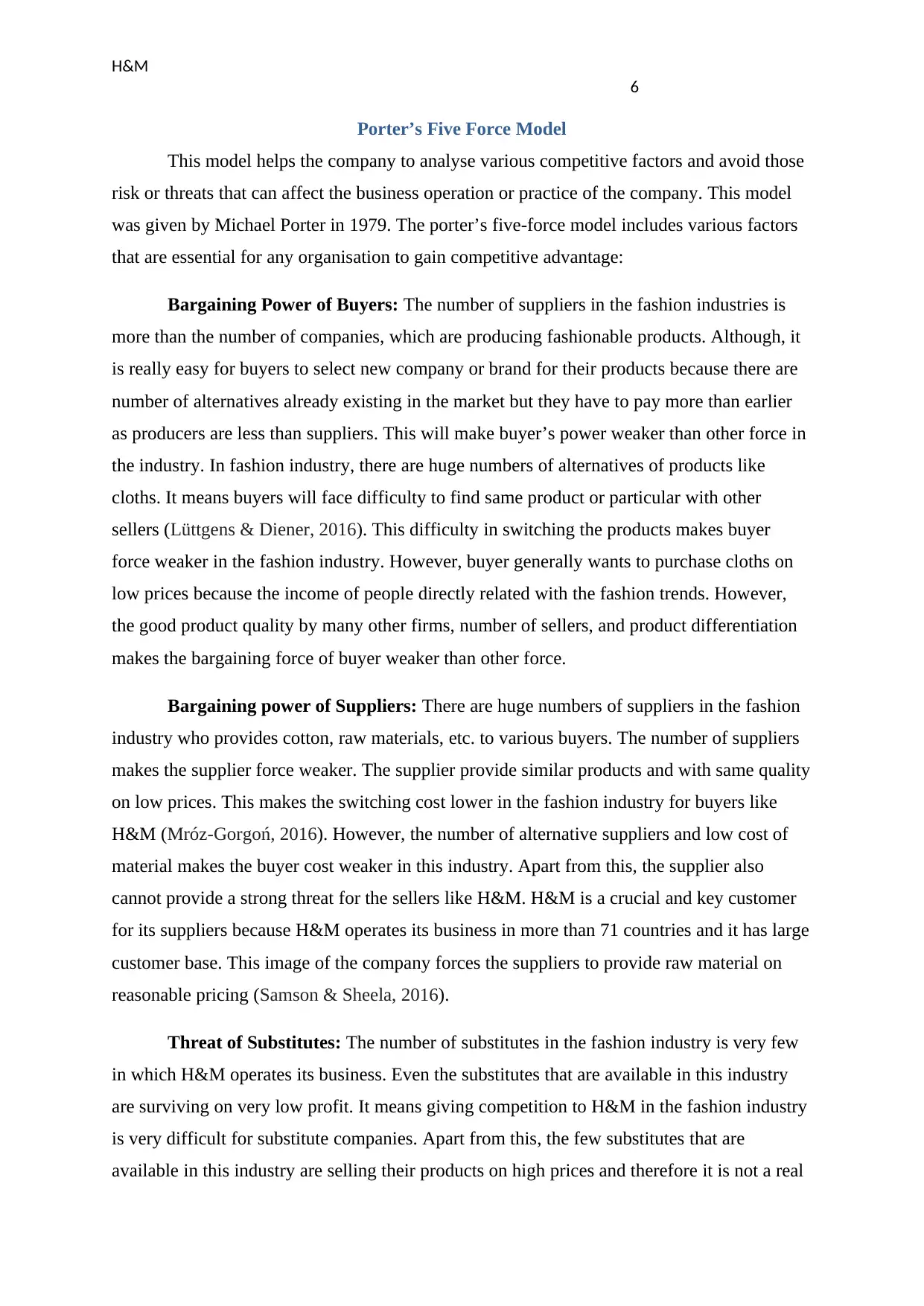
H&M
6
Porter’s Five Force Model
This model helps the company to analyse various competitive factors and avoid those
risk or threats that can affect the business operation or practice of the company. This model
was given by Michael Porter in 1979. The porter’s five-force model includes various factors
that are essential for any organisation to gain competitive advantage:
Bargaining Power of Buyers: The number of suppliers in the fashion industries is
more than the number of companies, which are producing fashionable products. Although, it
is really easy for buyers to select new company or brand for their products because there are
number of alternatives already existing in the market but they have to pay more than earlier
as producers are less than suppliers. This will make buyer’s power weaker than other force in
the industry. In fashion industry, there are huge numbers of alternatives of products like
cloths. It means buyers will face difficulty to find same product or particular with other
sellers (Lüttgens & Diener, 2016). This difficulty in switching the products makes buyer
force weaker in the fashion industry. However, buyer generally wants to purchase cloths on
low prices because the income of people directly related with the fashion trends. However,
the good product quality by many other firms, number of sellers, and product differentiation
makes the bargaining force of buyer weaker than other force.
Bargaining power of Suppliers: There are huge numbers of suppliers in the fashion
industry who provides cotton, raw materials, etc. to various buyers. The number of suppliers
makes the supplier force weaker. The supplier provide similar products and with same quality
on low prices. This makes the switching cost lower in the fashion industry for buyers like
H&M (Mróz-Gorgoń, 2016). However, the number of alternative suppliers and low cost of
material makes the buyer cost weaker in this industry. Apart from this, the supplier also
cannot provide a strong threat for the sellers like H&M. H&M is a crucial and key customer
for its suppliers because H&M operates its business in more than 71 countries and it has large
customer base. This image of the company forces the suppliers to provide raw material on
reasonable pricing (Samson & Sheela, 2016).
Threat of Substitutes: The number of substitutes in the fashion industry is very few
in which H&M operates its business. Even the substitutes that are available in this industry
are surviving on very low profit. It means giving competition to H&M in the fashion industry
is very difficult for substitute companies. Apart from this, the few substitutes that are
available in this industry are selling their products on high prices and therefore it is not a real
6
Porter’s Five Force Model
This model helps the company to analyse various competitive factors and avoid those
risk or threats that can affect the business operation or practice of the company. This model
was given by Michael Porter in 1979. The porter’s five-force model includes various factors
that are essential for any organisation to gain competitive advantage:
Bargaining Power of Buyers: The number of suppliers in the fashion industries is
more than the number of companies, which are producing fashionable products. Although, it
is really easy for buyers to select new company or brand for their products because there are
number of alternatives already existing in the market but they have to pay more than earlier
as producers are less than suppliers. This will make buyer’s power weaker than other force in
the industry. In fashion industry, there are huge numbers of alternatives of products like
cloths. It means buyers will face difficulty to find same product or particular with other
sellers (Lüttgens & Diener, 2016). This difficulty in switching the products makes buyer
force weaker in the fashion industry. However, buyer generally wants to purchase cloths on
low prices because the income of people directly related with the fashion trends. However,
the good product quality by many other firms, number of sellers, and product differentiation
makes the bargaining force of buyer weaker than other force.
Bargaining power of Suppliers: There are huge numbers of suppliers in the fashion
industry who provides cotton, raw materials, etc. to various buyers. The number of suppliers
makes the supplier force weaker. The supplier provide similar products and with same quality
on low prices. This makes the switching cost lower in the fashion industry for buyers like
H&M (Mróz-Gorgoń, 2016). However, the number of alternative suppliers and low cost of
material makes the buyer cost weaker in this industry. Apart from this, the supplier also
cannot provide a strong threat for the sellers like H&M. H&M is a crucial and key customer
for its suppliers because H&M operates its business in more than 71 countries and it has large
customer base. This image of the company forces the suppliers to provide raw material on
reasonable pricing (Samson & Sheela, 2016).
Threat of Substitutes: The number of substitutes in the fashion industry is very few
in which H&M operates its business. Even the substitutes that are available in this industry
are surviving on very low profit. It means giving competition to H&M in the fashion industry
is very difficult for substitute companies. Apart from this, the few substitutes that are
available in this industry are selling their products on high prices and therefore it is not a real
Paraphrase This Document
Need a fresh take? Get an instant paraphrase of this document with our AI Paraphraser
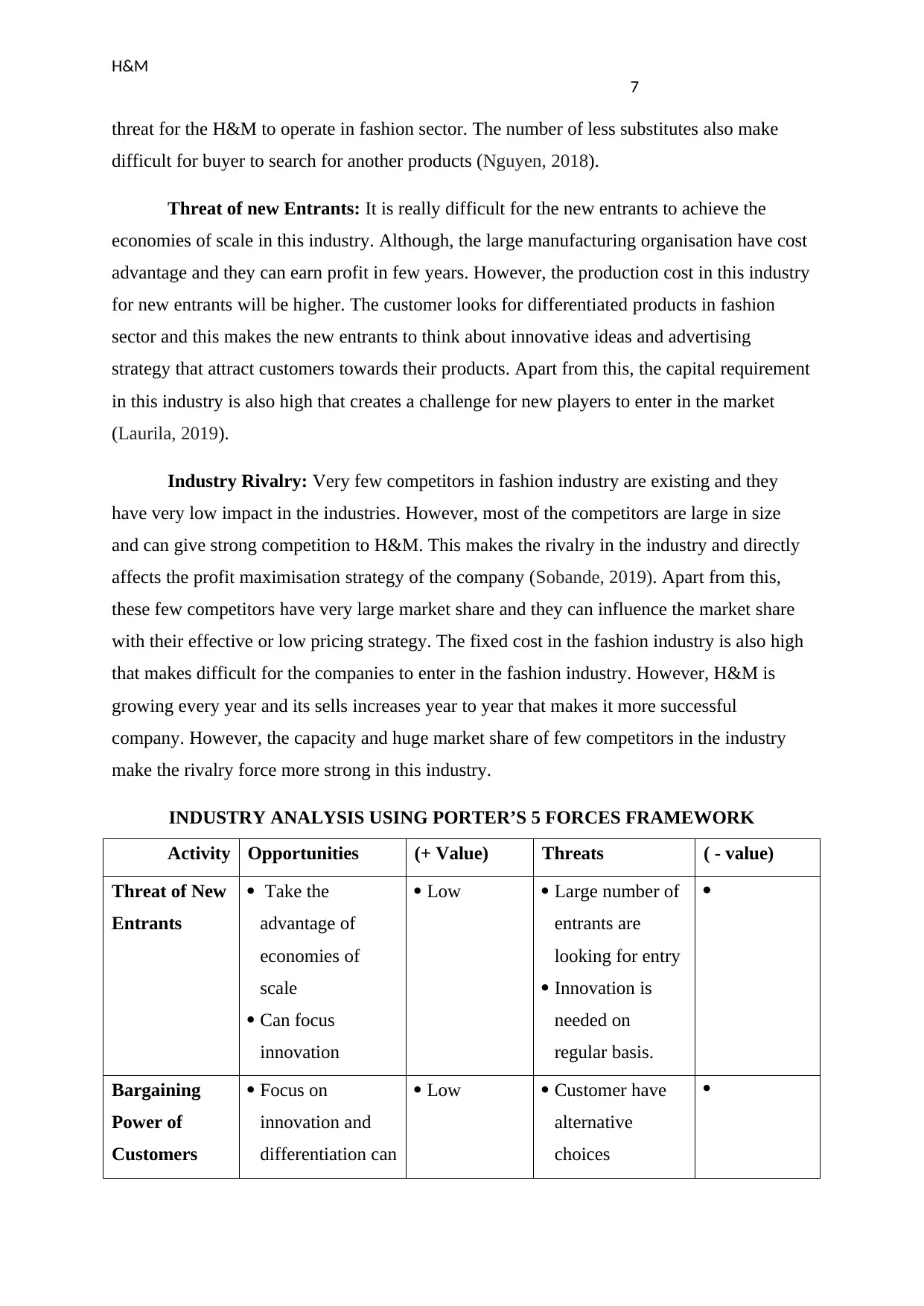
H&M
7
threat for the H&M to operate in fashion sector. The number of less substitutes also make
difficult for buyer to search for another products (Nguyen, 2018).
Threat of new Entrants: It is really difficult for the new entrants to achieve the
economies of scale in this industry. Although, the large manufacturing organisation have cost
advantage and they can earn profit in few years. However, the production cost in this industry
for new entrants will be higher. The customer looks for differentiated products in fashion
sector and this makes the new entrants to think about innovative ideas and advertising
strategy that attract customers towards their products. Apart from this, the capital requirement
in this industry is also high that creates a challenge for new players to enter in the market
(Laurila, 2019).
Industry Rivalry: Very few competitors in fashion industry are existing and they
have very low impact in the industries. However, most of the competitors are large in size
and can give strong competition to H&M. This makes the rivalry in the industry and directly
affects the profit maximisation strategy of the company (Sobande, 2019). Apart from this,
these few competitors have very large market share and they can influence the market share
with their effective or low pricing strategy. The fixed cost in the fashion industry is also high
that makes difficult for the companies to enter in the fashion industry. However, H&M is
growing every year and its sells increases year to year that makes it more successful
company. However, the capacity and huge market share of few competitors in the industry
make the rivalry force more strong in this industry.
INDUSTRY ANALYSIS USING PORTER’S 5 FORCES FRAMEWORK
Activity Opportunities (+ Value) Threats ( - value)
Threat of New
Entrants
Take the
advantage of
economies of
scale
Can focus
innovation
Low Large number of
entrants are
looking for entry
Innovation is
needed on
regular basis.
Bargaining
Power of
Customers
Focus on
innovation and
differentiation can
Low Customer have
alternative
choices
7
threat for the H&M to operate in fashion sector. The number of less substitutes also make
difficult for buyer to search for another products (Nguyen, 2018).
Threat of new Entrants: It is really difficult for the new entrants to achieve the
economies of scale in this industry. Although, the large manufacturing organisation have cost
advantage and they can earn profit in few years. However, the production cost in this industry
for new entrants will be higher. The customer looks for differentiated products in fashion
sector and this makes the new entrants to think about innovative ideas and advertising
strategy that attract customers towards their products. Apart from this, the capital requirement
in this industry is also high that creates a challenge for new players to enter in the market
(Laurila, 2019).
Industry Rivalry: Very few competitors in fashion industry are existing and they
have very low impact in the industries. However, most of the competitors are large in size
and can give strong competition to H&M. This makes the rivalry in the industry and directly
affects the profit maximisation strategy of the company (Sobande, 2019). Apart from this,
these few competitors have very large market share and they can influence the market share
with their effective or low pricing strategy. The fixed cost in the fashion industry is also high
that makes difficult for the companies to enter in the fashion industry. However, H&M is
growing every year and its sells increases year to year that makes it more successful
company. However, the capacity and huge market share of few competitors in the industry
make the rivalry force more strong in this industry.
INDUSTRY ANALYSIS USING PORTER’S 5 FORCES FRAMEWORK
Activity Opportunities (+ Value) Threats ( - value)
Threat of New
Entrants
Take the
advantage of
economies of
scale
Can focus
innovation
Low Large number of
entrants are
looking for entry
Innovation is
needed on
regular basis.
Bargaining
Power of
Customers
Focus on
innovation and
differentiation can
Low Customer have
alternative
choices
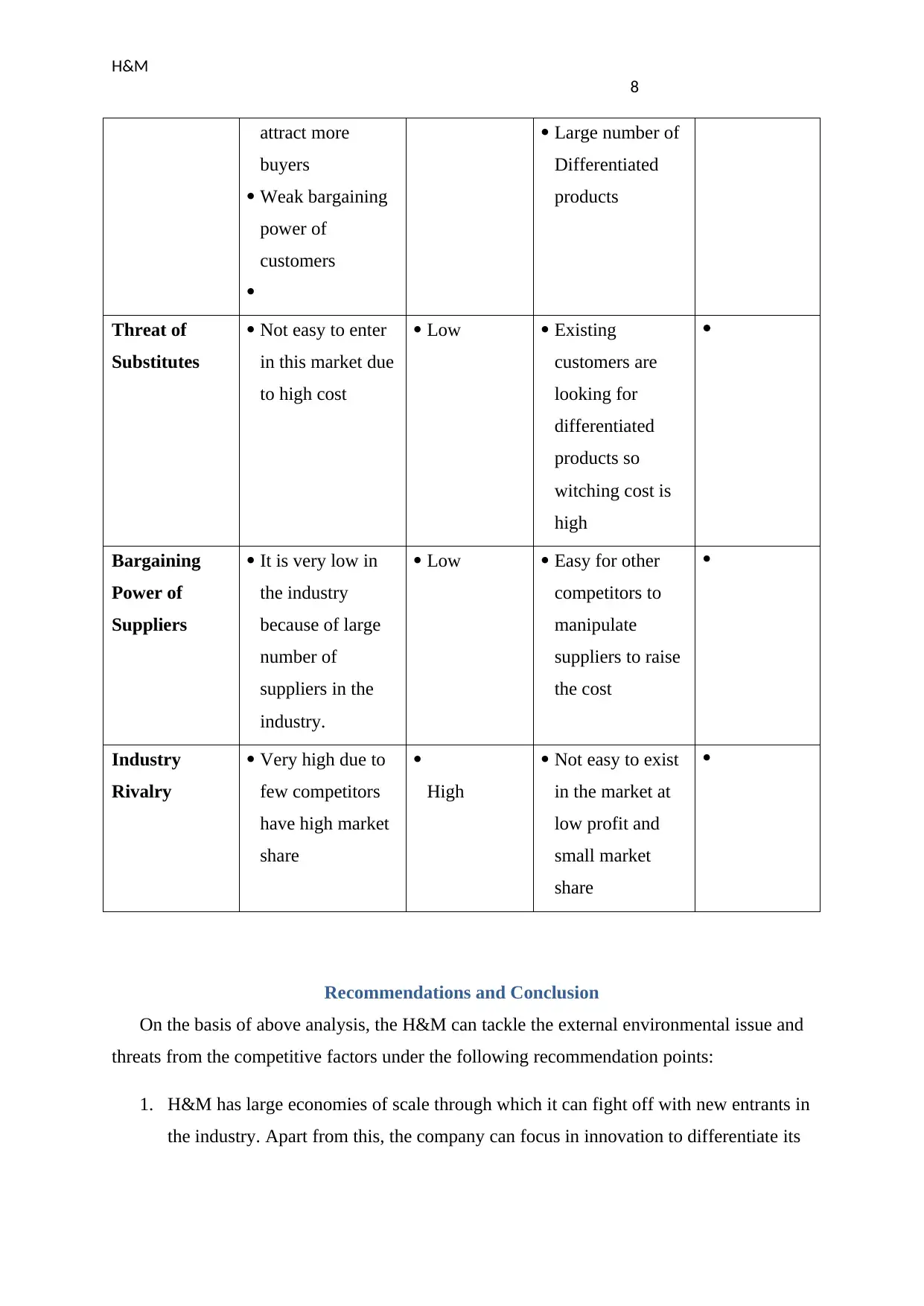
H&M
8
attract more
buyers
Weak bargaining
power of
customers
Large number of
Differentiated
products
Threat of
Substitutes
Not easy to enter
in this market due
to high cost
Low Existing
customers are
looking for
differentiated
products so
witching cost is
high
Bargaining
Power of
Suppliers
It is very low in
the industry
because of large
number of
suppliers in the
industry.
Low Easy for other
competitors to
manipulate
suppliers to raise
the cost
Industry
Rivalry
Very high due to
few competitors
have high market
share
High
Not easy to exist
in the market at
low profit and
small market
share
Recommendations and Conclusion
On the basis of above analysis, the H&M can tackle the external environmental issue and
threats from the competitive factors under the following recommendation points:
1. H&M has large economies of scale through which it can fight off with new entrants in
the industry. Apart from this, the company can focus in innovation to differentiate its
8
attract more
buyers
Weak bargaining
power of
customers
Large number of
Differentiated
products
Threat of
Substitutes
Not easy to enter
in this market due
to high cost
Low Existing
customers are
looking for
differentiated
products so
witching cost is
high
Bargaining
Power of
Suppliers
It is very low in
the industry
because of large
number of
suppliers in the
industry.
Low Easy for other
competitors to
manipulate
suppliers to raise
the cost
Industry
Rivalry
Very high due to
few competitors
have high market
share
High
Not easy to exist
in the market at
low profit and
small market
share
Recommendations and Conclusion
On the basis of above analysis, the H&M can tackle the external environmental issue and
threats from the competitive factors under the following recommendation points:
1. H&M has large economies of scale through which it can fight off with new entrants in
the industry. Apart from this, the company can focus in innovation to differentiate its
⊘ This is a preview!⊘
Do you want full access?
Subscribe today to unlock all pages.

Trusted by 1+ million students worldwide
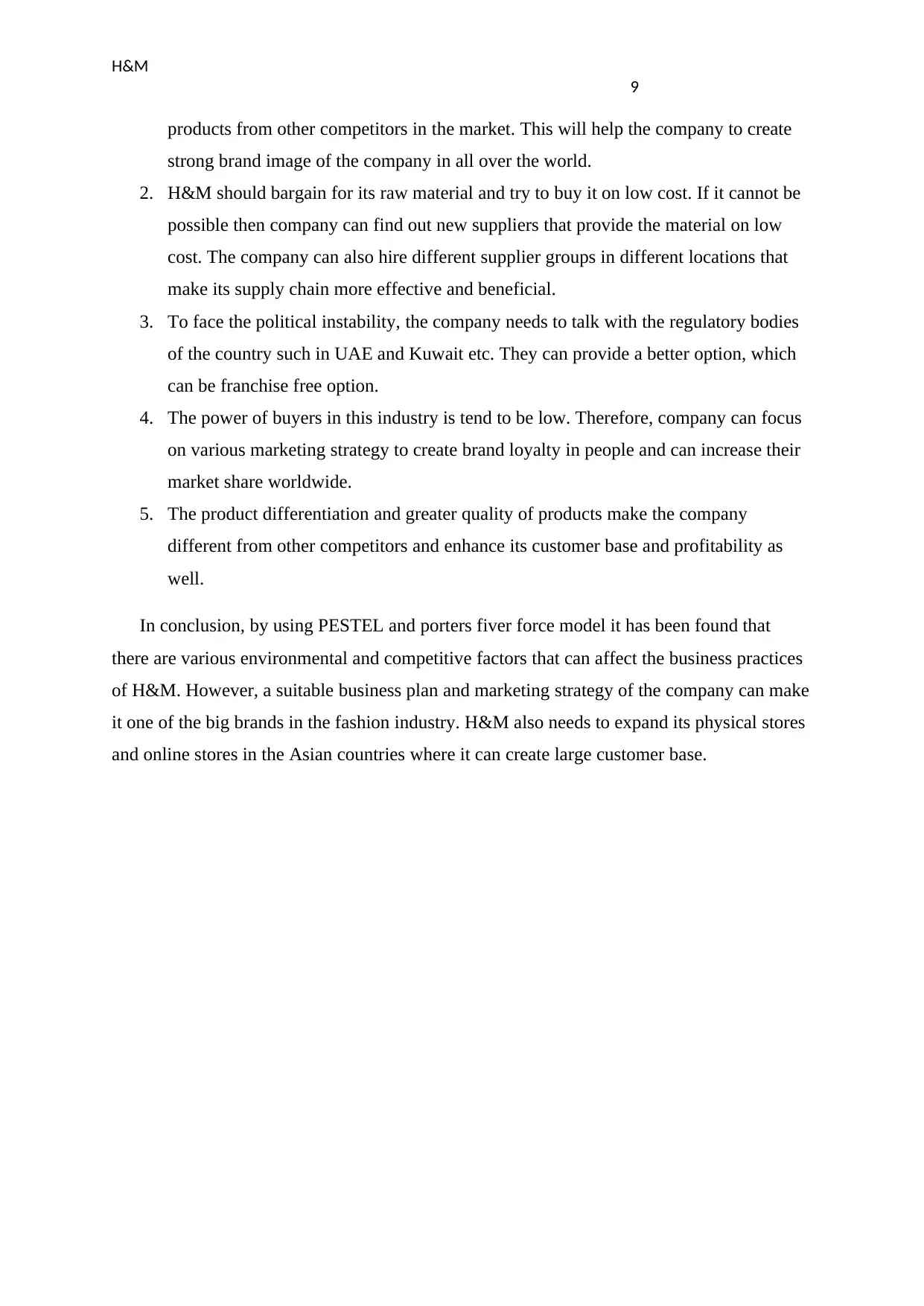
H&M
9
products from other competitors in the market. This will help the company to create
strong brand image of the company in all over the world.
2. H&M should bargain for its raw material and try to buy it on low cost. If it cannot be
possible then company can find out new suppliers that provide the material on low
cost. The company can also hire different supplier groups in different locations that
make its supply chain more effective and beneficial.
3. To face the political instability, the company needs to talk with the regulatory bodies
of the country such in UAE and Kuwait etc. They can provide a better option, which
can be franchise free option.
4. The power of buyers in this industry is tend to be low. Therefore, company can focus
on various marketing strategy to create brand loyalty in people and can increase their
market share worldwide.
5. The product differentiation and greater quality of products make the company
different from other competitors and enhance its customer base and profitability as
well.
In conclusion, by using PESTEL and porters fiver force model it has been found that
there are various environmental and competitive factors that can affect the business practices
of H&M. However, a suitable business plan and marketing strategy of the company can make
it one of the big brands in the fashion industry. H&M also needs to expand its physical stores
and online stores in the Asian countries where it can create large customer base.
9
products from other competitors in the market. This will help the company to create
strong brand image of the company in all over the world.
2. H&M should bargain for its raw material and try to buy it on low cost. If it cannot be
possible then company can find out new suppliers that provide the material on low
cost. The company can also hire different supplier groups in different locations that
make its supply chain more effective and beneficial.
3. To face the political instability, the company needs to talk with the regulatory bodies
of the country such in UAE and Kuwait etc. They can provide a better option, which
can be franchise free option.
4. The power of buyers in this industry is tend to be low. Therefore, company can focus
on various marketing strategy to create brand loyalty in people and can increase their
market share worldwide.
5. The product differentiation and greater quality of products make the company
different from other competitors and enhance its customer base and profitability as
well.
In conclusion, by using PESTEL and porters fiver force model it has been found that
there are various environmental and competitive factors that can affect the business practices
of H&M. However, a suitable business plan and marketing strategy of the company can make
it one of the big brands in the fashion industry. H&M also needs to expand its physical stores
and online stores in the Asian countries where it can create large customer base.
Paraphrase This Document
Need a fresh take? Get an instant paraphrase of this document with our AI Paraphraser
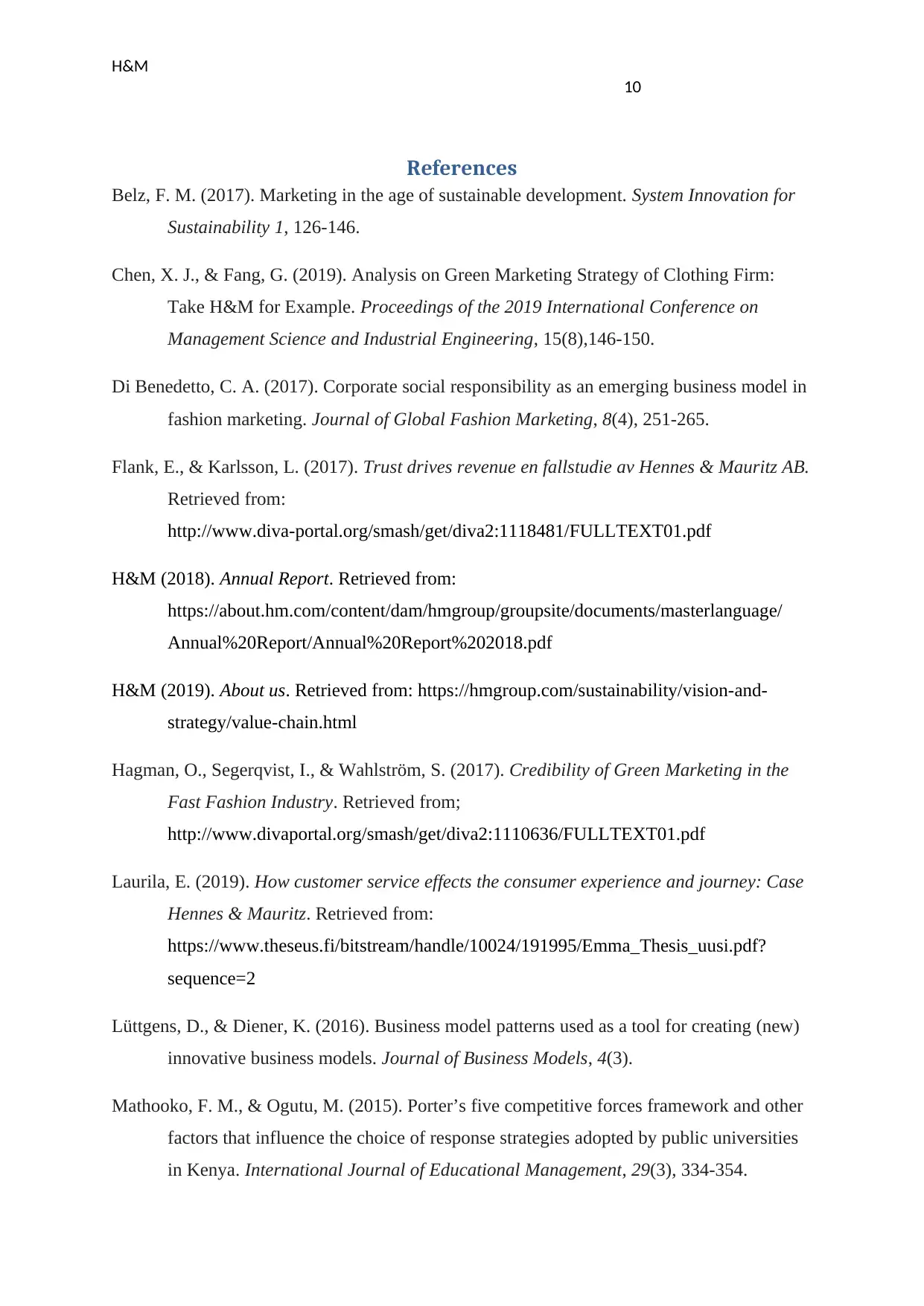
H&M
10
References
Belz, F. M. (2017). Marketing in the age of sustainable development. System Innovation for
Sustainability 1, 126-146.
Chen, X. J., & Fang, G. (2019). Analysis on Green Marketing Strategy of Clothing Firm:
Take H&M for Example. Proceedings of the 2019 International Conference on
Management Science and Industrial Engineering, 15(8),146-150.
Di Benedetto, C. A. (2017). Corporate social responsibility as an emerging business model in
fashion marketing. Journal of Global Fashion Marketing, 8(4), 251-265.
Flank, E., & Karlsson, L. (2017). Trust drives revenue en fallstudie av Hennes & Mauritz AB.
Retrieved from:
http://www.diva-portal.org/smash/get/diva2:1118481/FULLTEXT01.pdf
H&M (2018). Annual Report. Retrieved from:
https://about.hm.com/content/dam/hmgroup/groupsite/documents/masterlanguage/
Annual%20Report/Annual%20Report%202018.pdf
H&M (2019). About us. Retrieved from: https://hmgroup.com/sustainability/vision-and-
strategy/value-chain.html
Hagman, O., Segerqvist, I., & Wahlström, S. (2017). Credibility of Green Marketing in the
Fast Fashion Industry. Retrieved from;
http://www.divaportal.org/smash/get/diva2:1110636/FULLTEXT01.pdf
Laurila, E. (2019). How customer service effects the consumer experience and journey: Case
Hennes & Mauritz. Retrieved from:
https://www.theseus.fi/bitstream/handle/10024/191995/Emma_Thesis_uusi.pdf?
sequence=2
Lüttgens, D., & Diener, K. (2016). Business model patterns used as a tool for creating (new)
innovative business models. Journal of Business Models, 4(3).
Mathooko, F. M., & Ogutu, M. (2015). Porter’s five competitive forces framework and other
factors that influence the choice of response strategies adopted by public universities
in Kenya. International Journal of Educational Management, 29(3), 334-354.
10
References
Belz, F. M. (2017). Marketing in the age of sustainable development. System Innovation for
Sustainability 1, 126-146.
Chen, X. J., & Fang, G. (2019). Analysis on Green Marketing Strategy of Clothing Firm:
Take H&M for Example. Proceedings of the 2019 International Conference on
Management Science and Industrial Engineering, 15(8),146-150.
Di Benedetto, C. A. (2017). Corporate social responsibility as an emerging business model in
fashion marketing. Journal of Global Fashion Marketing, 8(4), 251-265.
Flank, E., & Karlsson, L. (2017). Trust drives revenue en fallstudie av Hennes & Mauritz AB.
Retrieved from:
http://www.diva-portal.org/smash/get/diva2:1118481/FULLTEXT01.pdf
H&M (2018). Annual Report. Retrieved from:
https://about.hm.com/content/dam/hmgroup/groupsite/documents/masterlanguage/
Annual%20Report/Annual%20Report%202018.pdf
H&M (2019). About us. Retrieved from: https://hmgroup.com/sustainability/vision-and-
strategy/value-chain.html
Hagman, O., Segerqvist, I., & Wahlström, S. (2017). Credibility of Green Marketing in the
Fast Fashion Industry. Retrieved from;
http://www.divaportal.org/smash/get/diva2:1110636/FULLTEXT01.pdf
Laurila, E. (2019). How customer service effects the consumer experience and journey: Case
Hennes & Mauritz. Retrieved from:
https://www.theseus.fi/bitstream/handle/10024/191995/Emma_Thesis_uusi.pdf?
sequence=2
Lüttgens, D., & Diener, K. (2016). Business model patterns used as a tool for creating (new)
innovative business models. Journal of Business Models, 4(3).
Mathooko, F. M., & Ogutu, M. (2015). Porter’s five competitive forces framework and other
factors that influence the choice of response strategies adopted by public universities
in Kenya. International Journal of Educational Management, 29(3), 334-354.
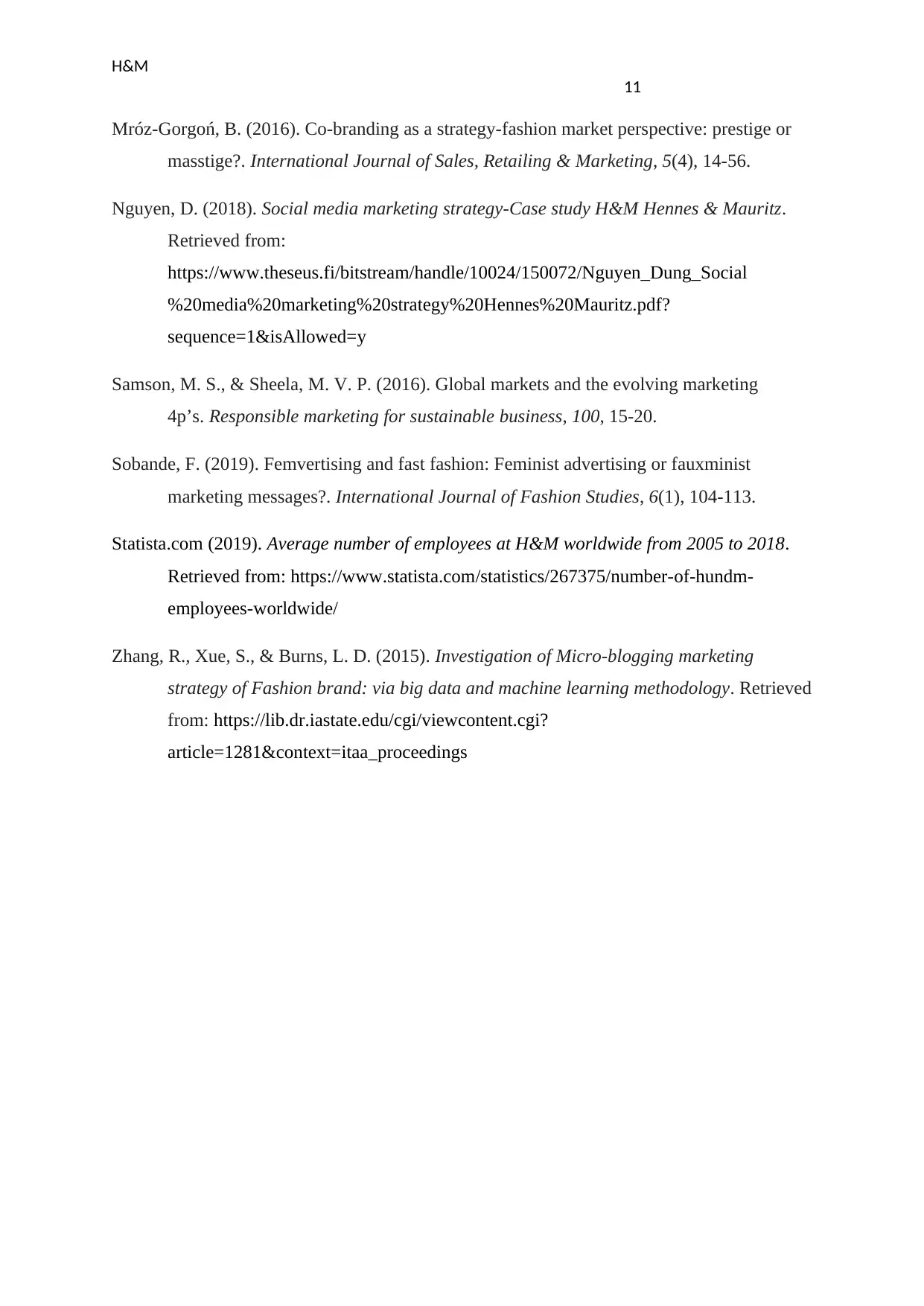
H&M
11
Mróz-Gorgoń, B. (2016). Co-branding as a strategy-fashion market perspective: prestige or
masstige?. International Journal of Sales, Retailing & Marketing, 5(4), 14-56.
Nguyen, D. (2018). Social media marketing strategy-Case study H&M Hennes & Mauritz.
Retrieved from:
https://www.theseus.fi/bitstream/handle/10024/150072/Nguyen_Dung_Social
%20media%20marketing%20strategy%20Hennes%20Mauritz.pdf?
sequence=1&isAllowed=y
Samson, M. S., & Sheela, M. V. P. (2016). Global markets and the evolving marketing
4p’s. Responsible marketing for sustainable business, 100, 15-20.
Sobande, F. (2019). Femvertising and fast fashion: Feminist advertising or fauxminist
marketing messages?. International Journal of Fashion Studies, 6(1), 104-113.
Statista.com (2019). Average number of employees at H&M worldwide from 2005 to 2018.
Retrieved from: https://www.statista.com/statistics/267375/number-of-hundm-
employees-worldwide/
Zhang, R., Xue, S., & Burns, L. D. (2015). Investigation of Micro-blogging marketing
strategy of Fashion brand: via big data and machine learning methodology. Retrieved
from: https://lib.dr.iastate.edu/cgi/viewcontent.cgi?
article=1281&context=itaa_proceedings
11
Mróz-Gorgoń, B. (2016). Co-branding as a strategy-fashion market perspective: prestige or
masstige?. International Journal of Sales, Retailing & Marketing, 5(4), 14-56.
Nguyen, D. (2018). Social media marketing strategy-Case study H&M Hennes & Mauritz.
Retrieved from:
https://www.theseus.fi/bitstream/handle/10024/150072/Nguyen_Dung_Social
%20media%20marketing%20strategy%20Hennes%20Mauritz.pdf?
sequence=1&isAllowed=y
Samson, M. S., & Sheela, M. V. P. (2016). Global markets and the evolving marketing
4p’s. Responsible marketing for sustainable business, 100, 15-20.
Sobande, F. (2019). Femvertising and fast fashion: Feminist advertising or fauxminist
marketing messages?. International Journal of Fashion Studies, 6(1), 104-113.
Statista.com (2019). Average number of employees at H&M worldwide from 2005 to 2018.
Retrieved from: https://www.statista.com/statistics/267375/number-of-hundm-
employees-worldwide/
Zhang, R., Xue, S., & Burns, L. D. (2015). Investigation of Micro-blogging marketing
strategy of Fashion brand: via big data and machine learning methodology. Retrieved
from: https://lib.dr.iastate.edu/cgi/viewcontent.cgi?
article=1281&context=itaa_proceedings
⊘ This is a preview!⊘
Do you want full access?
Subscribe today to unlock all pages.

Trusted by 1+ million students worldwide
1 out of 12
Related Documents
Your All-in-One AI-Powered Toolkit for Academic Success.
+13062052269
info@desklib.com
Available 24*7 on WhatsApp / Email
![[object Object]](/_next/static/media/star-bottom.7253800d.svg)
Unlock your academic potential
Copyright © 2020–2025 A2Z Services. All Rights Reserved. Developed and managed by ZUCOL.


